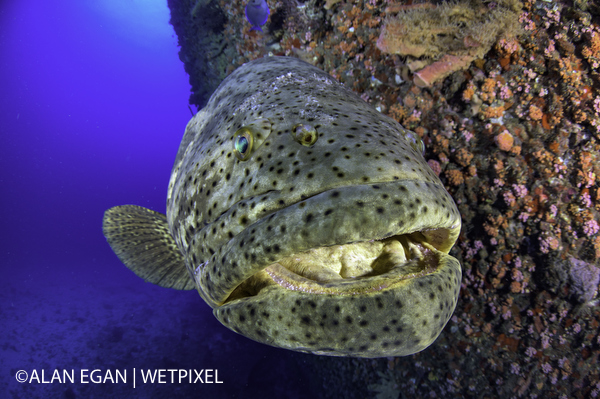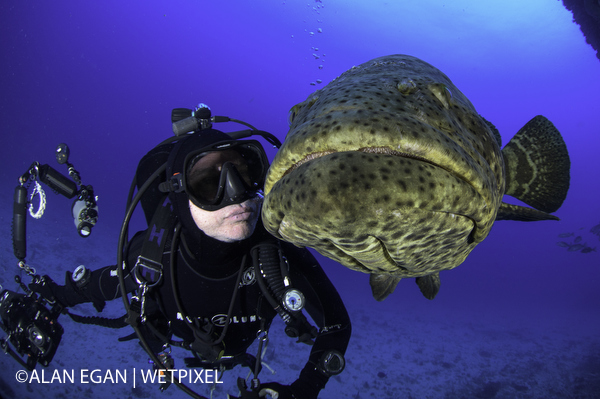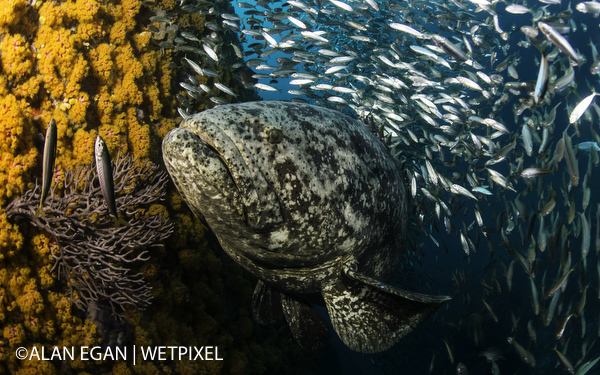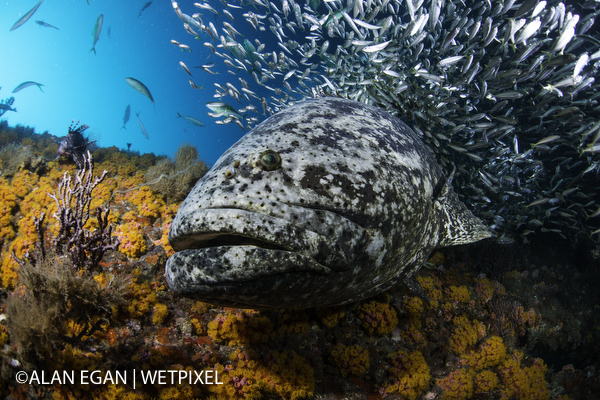Help Protect Florida Giant Groupers by Walt Stearns

Help Protect Florida’s Goliath Groupers
By Walt Stearns with images by Alan Egan.
In late April, the Florida Wildlife Commission (FWC) is meeting this week to discuss opening a fishing season on the state’s goliath groupers (Epinephelus itajara). Please make your voice heard for their protection.
Goliath groupers will be on the agenda on Thursday April 26th, starting at 8:30 am, at the Marriott Fort Lauderdale North. You can view the entire agenda for this two-day Florida Wildlife Commission (FWC) meeting here.
There will be an opportunity for public input from those attending this FWC meeting following FWC’s staff report to the FWC commissioners. Standard practice generally allows each speaker two to three minutes to voice their concerns on the subject, in this case, reopening a fishing season on Florida’s iconic goliath groupers.
Why this meeting is taking place
Management philosophies among Florida stakeholders (resident fishermen, divers, etc. in Florida) for goliath grouper are highly divergent, ranging from a no-take perspective for the preservation of the fish for ecotourism at one end, to a strong desire to reopen them to fishing due to the belief that their numbers have more than recovered and they are now a “nuisance species.”
Currently the FWC is looking into two management options:
a. Keep everything status quo — the fish retains all protected measures that have been in place since 1990.
b. Open the fish to a limited harvest (primarily in state waters) to recreational fishing groups.
Currently, the FWC is attempting to entertain the latter (b) on the contention that opening the fish up to a limited harvest will create a “unique fishing opportunity.”
FWC is proposing that a limited harvest would be handled through a random drawing for approximately 100 kill tags. The actual fee for each individual tag is still undetermined but the maximum amount that could be collected is capped at USD $300.
Should this limited harvest happen implemented, the FWC’s proposed slot size (the size range that would permissible for retention) is between 47 and 67 inches (essentially 4 feet to 5.5 feet max.).
So, what could possibly go wrong in letting the FWC carry this out?
Potential problems with opening even a limited season
Let’s begin with the proposed slot size. Fish in the upper end of the size range proposed by the FWC are fish that have begun moving out of the intra-coastal waters to join breeding age fish on offshore reefs and wrecks.

Goliaths spend the first five to six years of their life in intracoastal estuarine habitats. By the time they are ready to move offshore and populate coastal reefs and wrecks they are approximately four feet long. Although they still have a few more years of growing before they too come to age to breed (peak fecundity is 12 to 15 years of age for these fish) they are already commonly embedded with the adult population in the 5.6 to 6.5 feet plus range, tipping the scales between 250 and 500 pounds. Hence, generally that means in order for anyone to find and catch a fish in the slot-size range proposed by the FWC they will likely capture of larger breeding age adults.
Pulling fish up from wrecks and reefs in the 80-foot plus range will likely result in grievous injury (even to the point of fatal) to those fish. What is not included is the likelihood for additional mortality due to the fish being brought to surface too quickly, causing internal damage and improper handling of the fish as it is being landed. There is also the potential for an exponential rise in poaching activity as it will be harder for the FWC, with their limited resources in law enforcement, to track and clarify which fish was or was not landed legally.
The black bear hunt as precedent
If you think this couldn’t happen, look back to Florida’s 2015 controversial black bear hunt.
Originally, the season was planned to last one full week with a limit on adult bears take at no more than 320 individuals. Instead, the limited hunting season was abruptly stopped (Sunday, Oct. 29, 2015) just two days into a season, because the total number of bears killed by hunters had already reached 298 black bears. Hunters killed not only adults, but a large number of teenage bears as well as cubs.
In a Washington Post op-ed, the newspaper cited that the Florida chapter director of Humane Society of the United States wrote that the FWC’s reasoning for the bear hunt “ignores science,” noting that black bears were listed on Florida’s Endangered and Threatened Species List as recently as 2012. A state judge who denied an injunction to stop the hunt agreed that much of the science that FWC was using to justify it was weak. Remember this last point when you read further down.
The bottom line: wildlife management by politics instead of biology and scientific data does not work.
The heavy-metal problem
The most recent study published in the MARFIN project final report for NOAA on regional age structure, reproductive biology and tropical patterns of adult goliath grouper in Florida, using data provided by the FSU fish biological department, found levels of methyl mercury in adult goliath groupers that were frightening to say the least.
Part of FSU doctoral student Chris Malinowski’s work on the presence of mercury in goliath groupers found MMHg concentrations in the muscle tissues (filet portion) among the younger fish in the 4.5 to 5.2-foot range averaged 1.5 ppm, with maximum figures as high as 2.6 ppm. More disturbing, older fish in the 6 to 7-foot-plus size class, concentrations were as high as 4.5 ppm. Read the article explaining mercury poisoning here.
The US Food and Drug Administration’s “action level” (which the FDA may prohibit sale of fish) is 1.0 ppm. In comparison, the EPA draws their red line for consumption at 0.3 ppm. The Natural Resources Defense Council (NRDC) draws their line at 0.5 ppm. This is considered a “very high” threshold for human consumption.
The FWC’s own fishery management staff know all this, but are still allowing the commissioners to push an agenda that the data does not support.

Where does this fish’s true economic value lie?
Right now, the proposal for a limited harvest would entail no more than 100 individual fish taken at cost of up to $300 per fish to the fisherman for the kill tag.
This would yield the state $30,000.
Compare that to a dive charter, which can fill a boat with divers specifically to see goliaths, particularly during their spawning season from late July to early October. This renders far more revenue for the state. In addition to a $1,200 to $1,500-plus payday for every day that a boat goes out, most of that is in charter fees between $75.00 and $90.00 a pop. Divers rent gear, stay in hotels, eat at restaurants, and rent cars. One 15-passenger dive charter running 30 days consecutively can make over $35,000.
Note that September is “goliath grouper month” in Palm Beach County and the image of a goliath with a diver transfixed on it is, as of 2017, the new logo for Palm Beach County Artificial Reef Program.
The blame game
The call to action for reopening the fish for harvest revolves around the belief that the goliath groupers are eating all the legal-size grouper, snapper and lobster. The key word there is “legal size.”
Where have all the legal-size grouper, snapper, hogfish and lobster gone? Best look to the right and left at everyone in the room, as well as in the mirror.
Who is eating all the lobster?
Depending on location, the two-day sport season allows six or 12 lobsters per person, per day. Not that everyone adheres to the rule. In the 2015/2016 season, the FWC issued approximately 155,000 recreational-lobster permits, resulting in approximately 1.5 million pounds of lobster harvested in Florida waters by the end of the 2016 season.
Ethical value
We’ve all heard that “they are beautiful, majestic creatures that should not be hunted” from those opposed to lifting the protective measures for these fish. I caution the use of those words to illustrate your stand on goliath grouper — you’ll lose the attention of every commissioner in the room as they’ve heard that comment from many an environmentalist before. The fact is that grouper stocks all around the planet are falling. At present, there are few healthy spawning grounds left for any species of grouper.

Conservation status of the goliath
Currently, the organization International Union for Conservation of Nature (IUCN) has the Atlantic goliath grouper (Epinephelus itajara) on the Red List of threatened species as Critically Endangered.
Outside of Florida, the number of documented spawning aggregation sites for all six species of giant grouper in the genius Epinephelus — showing any signs of activity — can be counted on one hand with more than couple fingers left over.
The IUCN Red List currently lists the Pacific giant grouper (Epinephelus lanceolatus), the closet kin to the Atlantic and Eastern Pacific goliath, as Vulnerable. Martin Russell is the assistant director with the department of the environment, Parks Australia, tasked with managing the Coral Sea and North Australia Commonwealth marine reserves. Although Australia places the giant grouper under complete protected status like our own goliath grouper was some 11 years ago, there still remains not a single sign of the fish making any kind of measurable comeback. It took more than 15 years (1990 to 2015) before we began experiencing a favorable sign of this fish coming back in U.S. waters.
Outside of Florida, the only known spots with even a handful of adult goliath groupers left are in Cuba’s Garden of the Queen marine preserve and a few isolated spots in Brazil. These are still subjected to illegal fishing activity.
Consider how special it is, then, to see a dozen or more grouper together in one location. These spawning aggregations are becoming unique to Florida waters. And as such, a new high-ticket tourist attraction. And they’re worth protecting. Please make your voice heard in writing or in person at the upcoming FWC meeting.
TO GET INVOLVED OR ATTEND THE MEETING, CONTACT AUTHOR WALT STEARNS.
About the author
From ocean animals to fashion models, Walt Stearns has an eye for life. As a professional photographer for more than 20 years, Walt Stearns has produced stunning images for a variety of magazines, travel agencies, wildlife organizations, television programs and much more. His scuba diving, boating, and sport fishing skills have allowed for travels around the world. Walt’s talents extend beyond the camera as a contributing editor, field editor and contributing columnist for several high profile magazines.